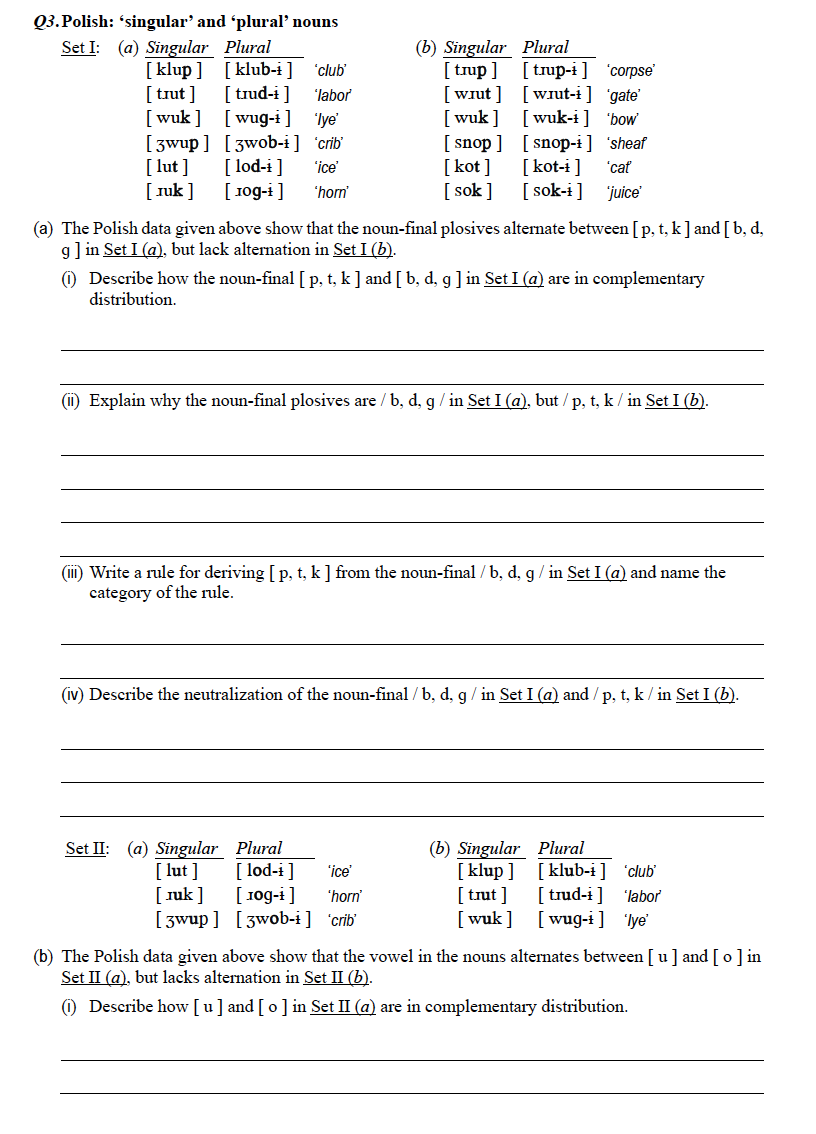Analyze the noun-final plosives in Polish sets I and II, explaining their complementary distribution, writing derivation rules, and describing neutralization.

Understand the Problem
The question is asking to analyze the alternation of noun-final plosives in Polish nouns provided in two sets, explaining their distribution, deriving rules, and describing neutralization in phonological terms.
Answer
Noun-final [p, t, k] and [b, d, g] in Set I (a) have complementary distribution; [b, d, g] are voiced in plurals. In Set II (a), [u] and [o] alternate similarly.
The noun-final [p, t, k] and [b, d, g] in Set I (a) are in complementary distribution as [b, d, g] appear in plural forms before a vowel, while [p, t, k] occur in singular forms at the end of a word. [b, d, g] are the underlying forms in (a) because they surface as voiced plosives in the plural form. Plosives [p, t, k] derive from /b, d, g/ in final position in Set I (a) due to word-final devoicing, a rule of phonological alteration. Neutralization occurs when the voicing distinction is lost. For vowels in Set II (a), [u] appears in singular, and [o] surfaces in plural forms before a vowel.
Answer for screen readers
The noun-final [p, t, k] and [b, d, g] in Set I (a) are in complementary distribution as [b, d, g] appear in plural forms before a vowel, while [p, t, k] occur in singular forms at the end of a word. [b, d, g] are the underlying forms in (a) because they surface as voiced plosives in the plural form. Plosives [p, t, k] derive from /b, d, g/ in final position in Set I (a) due to word-final devoicing, a rule of phonological alteration. Neutralization occurs when the voicing distinction is lost. For vowels in Set II (a), [u] appears in singular, and [o] surfaces in plural forms before a vowel.
More Information
In linguistics, complementary distribution occurs when two sounds never appear in the same phonological environments. Polish word-final devoicing is a common phonological process where voiced plosives become voiceless at the end of a word. Neutralization refers to losing distinctive features in certain environments.
Tips
Ensure to recognize the switch between singular and plural forms and identify environment-specific phoneme behaviors.
Sources
- Complementary distribution – Essentials of Linguistics, 2nd edition - ecampusontario.pressbooks.pub
- Lecture Notes and Other Handouts for Introductory Phonology - diu.edu
AI-generated content may contain errors. Please verify critical information